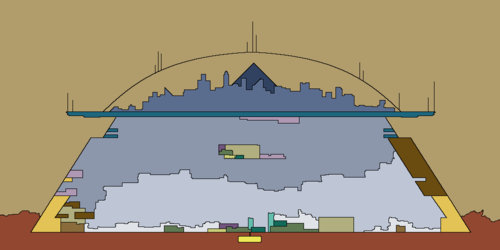Arcology
Arcology, a portmanteau of "architecture" and "ecology", is a vision of architectural design principles for very densely populated habitats. The concept has been primarily popularized, and the term itself coined, by architect Paolo Soleri at the start of the 21st century. Able to efficiently fit and support large numbers of inhabitants, they are commonplace on most sufficiently populated human worlds. On Mars, they house most of the population. Depending on the needs of the population, Arcologies often have everything from water and air reprocessing installations, through food and goods manufacturing, to malls and hotels. When acting as solitary structures without a supporting city, they often have their own power reactors (usually fusion and sometimes nuclear) or artificial gravity generators in case of low gravity worlds. Monuments to human ingenuity and engineering, smaller ones are capable of holding thousands if not tens of thousands of inhabitants, while the largest city sized ones (often dwarfing everything else in the landscape) are recorded of holding and supporting up to a few million inhabitants. Due to the efficient nature of such structures, they are often interconnected to each other, forming so-called 'Hives'.
Specifics

On the right is a color-coded internal schematic of 'Liberty' arcology in Lowell City, Mars. The colors represent areas depending on their current usage. While almost every arcology starts of with a designed segregation, supply and demand of limited space, decay, restructuring and upgrades inevitably lead to change in zone usage and demographics. As such, most of the areas marked as blue are divided by land value, or the worth of a cubic meter of space. The land value of a cubic meter, like any real estate, depends on what is nearby and the overall structural quality of the area.
The lowest areas are dedicated to various supporting facilities such as power generation, gravity generators, water, air and garbage processing. On the right and left sides (yellow and brown) are cargo and production areas, where goods and supplies are produced, imported and exported using different methods, be it spacecraft, aircraft, trains or trucks. The cargo areas are usually directly connected to underground or aboveground highways that lead traffic in and out of the arcology.
Directly above the supporting facilities are the lowest value apartments and services (light blue) occupied by the poorest. Going up, the darker blue area is what is arguably a better area to live in, with larger apartments and better services. This area is usually occupied by the middle class. The center of the arcology usually contains the most important services such as hospitals, management, law enforcement and public mess halls.
The top of the arcology is often referred to as the 'Crown'. There are many different types of crowns on Mars alone and are usually designed with specific goal in mind. Examples where it functions as Space Port, Space Elevator anchor or a military base aren't uncommon. In case of Liberty, it is a Biodome of massive proportions, with clean air, parks and a small city of its own. With the largest land value in the arcology, tt houses the creme of Martian society, with corporate offices, universities, luxury hotels and apartments.
An arcology of this type and size houses up to a 200,000 inhabitants, but the real number tends to swell much above that due to slumming and commuters.